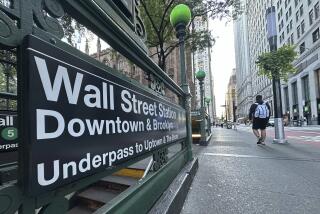FINANCIAL MARKETS HEAD Dow Up 32.08; Stocks Renew Strong Rally
- Share via
NEW YORK — The stock market rallied with renewed force Friday, extending the monthlong advance that has carried it to new highs since the crash of 1987.
Analysts said stock prices got a strong boost in the waning minutes of the session from professionals engaged in computer-program strategies.
The Dow Jones index of 30 industrials jumped 32.08 to 2,409.46, closing above 2,400 for the first time since it stood at 2,412.70 on Oct. 14, 1987.
For the week, the index rose 72.40 points.
Advancing issues outnumbered declines by about 9 to 5 in nationwide trading of New York Stock Exchange-listed stocks, with 938 up, 523 down and 490 unchanged.
Volume on the floor of the Big Board came to 187.31 million shares, up from 175.97 million in the previous session. Nationwide, consolidated volume in NYSE-listed issues, including trades in those stocks on regional exchanges and in the over-the-counter market, totaled 218.44 million shares.
The market suffered a temporary setback Thursday when the West German central bank announced unexpected increases in its official interest rates.
That raised fears of downward pressure on the dollar, and of possible further credit-tightening in this country.
By Friday, however, analysts said investors seemed to be taking the view that the Federal Reserve would wait a while longer to gauge the effects of the restrictive moves it has already made over the past year or so. Thus, observers noted, the possibility remained open in many minds that interest rates are close to or at a peak.
Stocks did most of their climbing just before the close in a barrage of program-trading activity linked to a set of expiring options and futures on stock indexes and individual stocks.
American Telephone & Telegraph, the nation’s most widely held stock with about 2.7 million shareholders, gained 1 1/4 to 34 3/4. The company’s report earlier in the week of a 20.7% first-quarter earnings increase was warmly received by investors.
Other gainers among the blue chips included International Business Machines, up 1 1/8 at 113 1/2; Exxon, up 3/4 at 44 5/8; General Motors, up 3/8 at 42 7/8; General Electric, up 1/2 at 48 3/8, and International Paper, up 1 at 50.
In Tokyo, the 225-share Nikkei index closed down 155.34 points at 33,029.81 after sliding 404.63 points in early trade on initial worries the West German move and higher oil prices would force Japan to raise its own official discount rate.
In London, share prices on London’s Stock Exchange closed narrowly mixed Friday, having recovered from their lowest levels after a rise in British interest rates failed to materialize.
The Financial Times 100-share index closed down 3.4 points at 2,061.0.
Credit
Bond prices climbed back after investors concluded that other major central banks were not on the verge of raising interest rates to match Thursday’s increases by West Germany.
The Treasury’s benchmark 30-year bond rose 11/32 point, or $3.44 per $1,000 face amount. Its yield, which moves in the opposite direction from its price, slipped to 8.98% from 9.01% late Thursday.
In the secondary market for In the tax-exempt market, the Bond Buyer index of 40 actively traded municipal bonds rose 1/16 point. The average yield to maturity fell to 7.64% from 7.65% late Thursday.
Yields on three-month Treasury bills remained at 8.93% as the discount stood unchanged at 8.63%. Yields on six-month bills rose to 9.09% as the discount jumped 10 basis points to 8.59%. Yields on one-year bills fell to 9.32% as the discount lost 1 basis point to 8.61%.
A basis point is one-hundredth of a percentage point. The yield is the annualized return on an investment in a Treasury bill. The discount is the percentage that bills are selling below the face value, which is paid at maturity.
The federal funds rate, the interest on overnight loans between banks, traded at 9 13/16%, down from 9.875% late Thursday.
More to Read
Inside the business of entertainment
The Wide Shot brings you news, analysis and insights on everything from streaming wars to production — and what it all means for the future.
You may occasionally receive promotional content from the Los Angeles Times.










